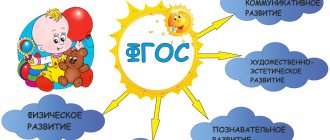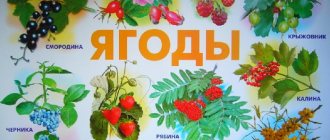Toy theme
Materials found: 31 Shown: 1 — 10
Project “Toys and I are friends!”
Municipal budgetary preschool educational institution “Kindergarten No. 14” Project activity with children of primary preschool age on the topic “Toys and I are friends” Junior group teacher Vasina…
"My favorite doll." Abstract of GCD in the educational field "Artistic and Aesthetic Development" in the middle group
The educational field “Artistic and Aesthetic Development” strengthens the ability to convey the shape, arrangement of parts of the human figure, their relative size, learn to draw large, on the entire sheet. Practice drawing and...
Lesson on speech development in the senior group “Journey to the Land of Toys”
Educational area: Speech development Objectives: Teach children to find the missing sound in a word. Learn to name objects in the plural. Continue to learn how to compose sentences and practice composing fairy tales. Develop speech...
Plan for holding a thematic week “Games and Toys” in the 2nd junior group
Goals and objectives of the thematic week “Games and Toys”: - developing children’s interest in various types of games and toys; — support for free creative self-realization in the game; — development of cognitive activity; - optimal...
Calendar planning for the summer health period in the middle group. Thematic week “My favorite toy”
Thematic week “Favorite toys” Monday Morning exercises D/I “Ask for a toy” Goal: to teach children effective ways of communication. Observation and work in a corner of nature. Goal: to strengthen children’s skills in caring for...
Open physical education lesson in the first junior group “Favorite toys, balls and rattles”
Goal: to teach children to walk and run without bumping into each other; throw the ball forward from behind the head; develop the ability to jump on two legs in place; strengthen crawling skills; develop a desire to play outdoor games with the teacher...
Holiday script for kids “Journey to the Land of Toys”
Goal: to develop the ability to move to the rhythm of the melody; develop emotional responsiveness; cultivate a good attitude towards the toy; bring joy to children from playing with their favorite toys. Equipment: boxes with toys - dolls: hare, ...
Summary of GCD in the 2nd junior group “Toy Store”
Goal: Generalize children's knowledge about toys. Generalization of knowledge about the work of A. Barto. Objectives: To form a positive attitude towards the heroes of works in the works of A. Barto. Cultivate a caring attitude towards toys. ...
Photo report “Day of Favorite Toys”
Our kindergarten hosted a themed week called “Favorite Games and Toys.” The kids had an exhibition called “Parade of Favorite Toys.” Children and their parents brought toys from home. While viewing the exhibition, the children acted out a small…
Possibilities of toys in the development of vocabulary in young children
Every year, life requires an increasing amount of knowledge not only from us adults, but also from children.
One of the conditions for successful learning is well-developed speech. So, speech is a special form of communication between people, which... Pages:
All sections
Classes on the topic “Toys”
Children love to play with toys, so they have fun learning the names of toys in English.
So, what can you go through in this topic... My suggestions are as follows: dolly / doll (doll), car (car), train (train), blocks (cubes), plane (airplane), robot (robot), drum (drum) , trumpet (pipe), ball (ball), teddy bear (bear), boat (boat)
And now classes on the topic.
1. Flashcards. You can't do without them. Children must connect the name with the visual image. Here you can read about different fun and interesting ways to present cards. Each lesson can be presented in different ways, thereby making the child look forward to the next lesson.
And here look at some cards in pdf format.
2. Hero. Where would we be without him? Children communicate with dolls and soft animals with greater pleasure than with an adult. Therefore, each lesson you can “invite a new hero to visit.”
Today we have a guest. This is a cat. Let's say hello to him. –HELLO – I wonder what his name is. Let's ask him. What's your name? (in a different voice) My name is Cookie. Oh, hello, Cookie.
Cookie greets each child. He may ask short questions. For example: What's your name? How old are you? At the same time, the hero must react vividly to the child’s answers.
For example: Oh, hello, Oleg. My name is Cookie. Let's be friends (shakes hands). You are 3?! You are a big boy/girl! I am 2. I am a little cat.
Don’t forget that our topic is “Toys,” and we need the child to hear the name of this or that toy as many times as possible during the lesson. There are certainly options here.
For example, a hero can bring a bag of toys. Teacher: Cookie, what do you have? Hero: I have a bag? Teacher: What's there in the bag? Hero: There are toys in the bag. Teacher: Let's see. What is this? (the teacher says while taking out the toys, or the children can take turns getting the toys themselves) Hero: This is a train. Teacher: What color is the train? (the teacher asks the children) Children: Blue! Teacher: Yes, it is. This is a blue train.
And so we take out all the toys. Then... You have many toys, Cookie! Children, let's count Cookie's toys. 1,2,3,4….
The “Dunno” option is more suitable when children are already familiar with the words on the topic. We show the cards (or the toys themselves), and ask Cookie:
Teacher: What is this, Cookie? Cookie: Hmmm…. Trumpet (speaks incorrectly)? Children: No! Car! Teacher: Cookie, this is not trumpet. This is a car!
And we continue like this. Children love to feel smarter than someone else)
Using toys you can practice the phrases I like / I don't like and, accordingly, the question “What do you like?” , which according to our topic can be specified differently:
“What toys do you like?” “What toy do you like more?” “What toys don't you like?” “Do you like the car or the dolly?”
It's the hero's birthday.
Look, Cookie is crying. Today he has his birthday. But he has no presents! Let's sing a song and give Cookie presents.
Happy Birthday to you,
Happy Birthday to you,
Happy Birthday, dear Cookie,
Happy Birthday to you!
Cookie, take the car. Cookie, take the drum. …..
3. Songs. Listening to songs can be either active (when you listen together, sing and do some actions to the music, explain the meaning of the songs if it is completely unclear) and passive (when the children are engaged in coloring a picture on the topic, and you turn on the songs). Here is a list of songs on the topic that you can listen to and, if desired, download.
4. Video on the topic “Toys” here. (if you don’t know how to download a video from YouTube, write, I will definitely explain).
5. Coloring books. Many may discard this point with the words “children can practice drawing in art or at any other time.” But, as experience has shown, this is a great way to get even the most naughty children to listen and remember while they are busy doing something they love so much.
Don't give all the pencils at once, just one at a time. Ask “What color do you need?” . Depending on age and level of knowledge, children’s answers:
Blue. Blue, please. Can I have blue, please?
And there is no need to take a separate topic “Colors”, because the names of all colors can be fixed by going through any other topic.
Once the coloring pages have been distributed, play songs related to the theme. Children listen, remember, and then sing along.
Approaching each child separately, you say what he is drawing with words of encouragement. “What a nice green car! Very good.” “You have an orange car! Very nice! Good job!” “Have you finished coloring the car? Now color the train.” “I like your yellow train!”
You can view and download some coloring pages here.
6. Counting rhyme.
One and two, and three, and four We are sitting on the floor. We are playing with the ball And a pretty little doll.
7. Charging.
Children do not like to sit in one place, so we need to organize physical education sessions, but of course in English. Warming up in English is another great and effective way to teach children English. After all, properly carried out exercises turn into a fun game for a child, during which new vocabulary is reinforced or even learned.
Songs - rhymes for warming up, see here.
Surely you have your own original ideas for games on the “Toys” theme, please write, I will be glad to try something new with my children and others will probably also be interested!
We wait! If you find the material interesting, share it with your friends on social networks.
See also:
Video on the topic “Toys”
Memory game “Please”, “Thank you”, etc.
Online vocabulary game on various topics - Memory Match
Game "Name 3"
What educational toys should girls buy?
- From a very early age, parents buy completely different things for girls and boys: clothes, strollers, shoes and, of course, toys. After all, their interests will differ over the years
- Girls like dolls, jewelry of various kinds, kitchens, strollers. In addition, if you buy a bicycle or scooter for your baby, then it is better to choose a brighter color - not blue, black
- It is also better to buy all educational toys for girls that are bright and stylish. Some children, even from childhood, are strict about the appearance of such products.
What educational toys should I buy for my child depending on his age?
Starting from the age of one month, the baby should have toys to develop motor skills and visual attention. From the age of three months - rubber squeakers that make sounds, doll dolls. After six months, use cars, books, and cubes to play. From nine - special pyramids, construction sets for kids, cars. When the baby turns one year old, toys for fine motor skills are suitable.
IMPORTANT: No matter how beautiful educational toys are, know that you need to play with the child and give him maximum attention.
How many toys does a particular child need?
Toys are often purchased in large quantities simply out of love or out of the need to compensate your child for the time that parents cannot spend with him. But too much entertainment slows down the baby’s development, and many of the things that their relatives bring to them soon cease to interest them. So it turns out that there are a lot of toys, but nothing to play with. In particular, very young children often limit themselves to one pet with whom they constantly play.
Toys help develop a child's thinking
As you know, children should live in a world of kindness and beauty. The adults who surround him can create such a world for a child. Of course, this is not an easy task, but still, adults can do it. Adults must understand that even the simplest, first toys for a child are not just everyday household items. Oddly enough, it is these toys that begin to educate and develop a culture of thinking and behavior in a child. It is thanks to them that the baby is able to develop intellectually and mentally.
Types of educational toys by age
Another important factor when choosing educational toys is the division of toys by age. As children grow, toys will change.
Educational toys can be divided into several categories:
- interactive - toys that can move, play a melody, tell rhymes and fairy tales, teach the alphabet and counting, bark, meow and talk;
- puzzles - small pictures from which you can put together a whole picture, help develop fine motor skills, logic and imagination;
- sorters - toys - inserts, pyramids, nesting dolls: objects with certain characteristics, differing in size, color and shape, will help develop logic, learn colors, letters and numbers;
- puzzles - develop logic and thinking;
- constructors - sets of many parts and connecting elements that allow you to assemble various structures;
- board educational and sports games help to explore the world and broaden one’s horizons;
- cubes are a real find, a reusable “building material” from which you can endlessly build houses, towers, tunnels, bridges, and cubes with letters will help you learn to read and count.
- gurneys - toys for little ones, on wheels with a handle or rope, help a child learn to walk faster;
- bathing toys, sandboxes, toys - squeakers, knockers, balls and others.
Psychologists have proven that toys of bright red and black colors negatively affect the mental development of children. Therefore, we recommend buying multi-colored toys. They will help your baby learn colors and train their eyesight.
How to choose the right toy according to the child’s age: of course, on all toys the manufacturer indicates the age of the child for whom the toy is intended: it must be functional and safe.
What educational toy to buy for a child: tips and reviews
- Based on the reviews of many mothers, we can conclude that educational toys must be of good quality (how to determine that a product is of high quality has already been described above)
- It is best to buy products made from natural materials
- Toys should not have small objects or sharp parts
- Toys must be selected individually. Some children are interested in playing this game, while others are not interested at all.
Important: Consider the child’s preferences; each child has developed different talents.
Educational paper toys
To make your own paper toy, you will need glue, scissors, colored paper and imagination. For younger children, you can make a simple airplane; almost every parent knows how to fold it from a regular piece of paper. For older children it will be interesting to make an applique, a three-dimensional figure, snowflakes.
If you don’t have the time and talent to make complex figures, then you can simply buy special paper toys in online stores, especially since there are many different kinds of “cut-outs”, ready-made pictures that you just have to glue together according to the instructions described.
DIY educational toys for children. How to make a useful toy for a child?
Let's look at an example of making a simple educational toy for kids of different ages, “Air Badminton.” We need to prepare the following materials:
- two plastic plates
- two wooden handles
- balloon
- Super glue
Inflate the balloon. Glue the finished handle to the plate. Make another one of the same racket. All badminton is ready. This is an entertaining game that the whole family can play.





